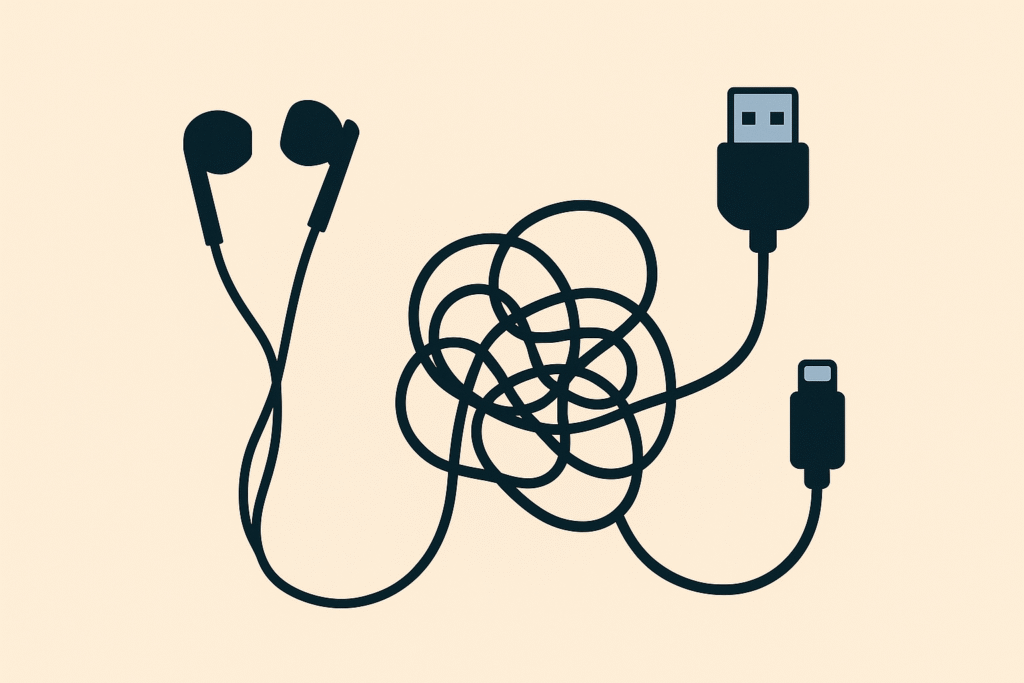A Nerdy Look at the Physics, Friction, and Frustration Behind Everyday Cable Knots
If you’ve ever reached into your backpack, desk drawer, or pocket and pulled out a snarled mess of headphones, charging cables, and adapter wires, you’ve probably thought:
“How does this even happen?”
Turns out, tangled cords aren’t just annoying—they’re inevitable. In fact, science has studied this, and the results are surprisingly fascinating. Let’s dive into the delightful chaos of why your tech accessories seem to stage a knotty rebellion every time you’re not looking.

🧪 The Physics of the Pocket Tangle
In 2007, physicists at the University of California, San Diego published a study called “Spontaneous Knotting of an Agitated String” in the Proceedings of the National Academy of Sciences. (Yes, this is real science.)
They dropped a string of varying lengths into a rotating box hundreds of times and measured how often it tangled on its own.
The verdict?
- More than 50% of the time, the string tied itself into a knot—spontaneously.
- The longer the string, the higher the chance of a knot forming.
- Cords longer than 1.5 feet were especially prone.
- Looser coils and higher movement made tangles worse.
So when your earbuds bounce around in your bag or a cable falls into a drawer? That’s chaos theory in action.
🔄 It’s All About Random Motion + Flexible Length
Here’s the simplified explanation:
Flexible cords naturally form loops. When jostled, those loops twist and pass through each other. Boom: a knot.
Imagine your cables as hyperactive toddlers in a bounce house. Left unsupervised? They’re going to twist, turn, and end up in a pile.
📐 Cable Shape and Thickness Matter, Too
Not all cords are equally annoying.
Cords more likely to tangle:
- Long and thin
- Flexible with no stiffness
- Lacking structure (i.e., cheap plastic insulation)
Cords less likely to tangle:
- Flat cables (the “linguine” design)
- Braided or fabric-wrapped cables
- Shorter lengths (under 1.5 feet)
So yes—that ultra-skinny free charger you got with your phone is more like a knot magnet than a power solution.
🔌 Why Wired Tech is Still a Thing
We know what you’re thinking: “Isn’t this why we have Bluetooth now?”
Sure. But:
- Bluetooth fails.
- Wireless devices still need charging (with cables).
- Audio purists prefer wired for quality.
- Some devices (like DSLRs or travel routers) still require old-school plugs.
Until every device charges via mental energy, we’re stuck with cords—and the knots they bring.
🧠 Why We Think It’s Worse Than It Is
Your brain also plays a trick here.
We don’t notice when a cord stays tidy. But when it tangles? It interrupts your routine. You remember it. You blame the cable.
It’s the same psychological principle that makes you think every stoplight turns red just for you when you’re late.
🧰 Tips to Keep Cables From Tangling (Without Buying Anything)
Yes, tech has tangled us. But you don’t need to throw money at the problem. Here’s how to keep your cables under control—with stuff you already have:
1. Use the “Over-Under” Wrap
Instead of just coiling the cable around your hand, alternate the loop direction: one overhand, one underhand. This method reduces tension and prevents twists.
2. Save Bread Ties, Twist Ties, or Rubber Bands
Wrap cords gently and secure them with a recycled twist tie. No fancy organizer required.
3. Store Cables Flat or in Grid Layouts
Instead of stuffing cords into a drawer, lay them side-by-side in a grid. Try an old eyeglass case, a mint tin, or toilet paper rolls in a box.
4. Keep Long Cables Separated
Don’t mix short and long cables together. Long ones are more likely to loop and tangle with everything else.
5. Label with Tape or Stickers
Identifying cables quickly reduces the time they spend jostling while you dig through a mess.
🤯 Weird Bonus Fact: Cables Have a “Minimum Frustration Length”
Physicists discovered there’s actually a length threshold for spontaneous tangling. Below it? Cords don’t knot. Above it? All bets are off.
That sweet spot is around 18 inches.
So if you only need a short charging cable for your desk—use a short one. Your sanity will thank you.
🎓 TL;DR: Tangling Is Inevitable—But Manageable
Here’s the bottom line:
- Cords tangle due to random motion, length, and loop formation
- The more flexible and longer the cable, the more likely it is to knot
- Smart habits (and a little physics) can prevent daily frustration
🧠 Final Thought: Embrace the Chaos—Then Outsmart It
Cables are annoying, but they’re also a reminder of how clever systems can form from total randomness. Your tangled earbuds aren’t trying to ruin your day. They’re just obeying the laws of probability.
But thanks to a little science—and some clever tricks—you can beat the system.
Stay untangled. Stay clever.
Want more posts like this? Follow @CleverGadgetry for fun, nerdy deep dives on the everyday tech you actually use.